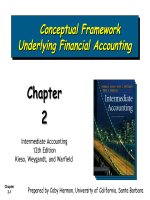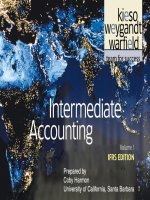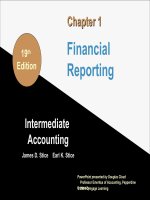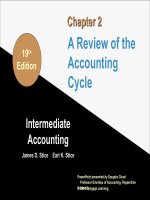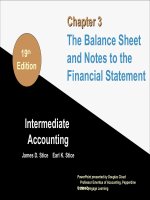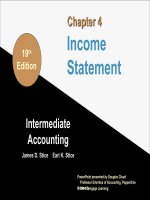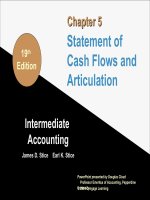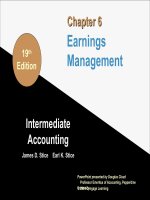Intermediate accounting 19th by stice stice chapter 02
Bạn đang xem bản rút gọn của tài liệu. Xem và tải ngay bản đầy đủ của tài liệu tại đây (165.11 KB, 50 trang )
Chapter 2
19th
Edition
A Review of the
Accounting
Cycle
Intermediate
Accounting
James D. Stice
Earl K. Stice
PowerPoint presented by Douglas Cloud
Professor Emeritus of Accounting, Pepperdine
University
© 2014 Cengage Learning
2-1
The Accounting Process
The
The Recording
Recording Phase
Phase
1. Business documents are analyzed.
2. Transactions are recorded.
3. Transactions are posted.
(continued)
2-2
The Accounting Process
The
The Reporting
Reporting Phase
Phase
4. A trial balance of the accounts in the
general ledger is prepared.
5. Adjusting entries are recorded.
6. Financial statements are prepared.
7. Nominal accounts are closed.
8. A post-closing trial balance may be
prepared.
2-3
Accounting Terminology
• Transactions are events that transfer or
change goods or services between or
among two or more entities.
• Business documents, such as invoices,
provide evidence that transactions have
occurred as well as the data required to
record the transactions in the accounting
records.
2-4
Accounting Terminology
• Double-entry accounting is an old and universally accepted system for recording
•
accounting data.
Each transaction is recorded in a way that maintains the equality of the basic
accounting equation:
Assets = Liabilities + Owners’ Equity
(continued)
2-5
Accounting Terminology
•
•
•
•
A debit is an entry on the left side of an
account.
A credit is an entry on the right side of
an account.
Assets, expenses, and dividends are
increased by debits and decreased by
credits.
Liabilities, capital stock, retained
earnings, and revenues are increased by
credits and decreased by debits.
2-6
Three-Step Journal Entry Process
1. Identify the accounts involved with an
event or transaction.
2. Determine whether each account
increased or decreased (this information,
coupled with the answer to step 1, will tell
you if the account was debited or
credited).
3. Determine the amount by which each
account was affected.
2-7
Analyzing Business Documents
•
Normally, a business document, or source
document, is the first record of each
transaction.
• The business document provides support for the data to be recorded
•
in the journals.
Documents underlying each recorded transaction provide a means of
verifying the accounting records and thus form a vital part of the
information and control systems.
2-8
Journalizing Transactions
•
•
•
Once the information provided on business
documents has been analyzed, transactions
are recorded in chronological order in the
appropriate journal or journals.
A special journal is used to record a
particular type of frequently recurring
transaction.
The general journal is used to record all
transactions for which a special journal is not
maintained.
2-9
Posting to the Ledger Accounts
•
•
•
An account is used to summarize the
effects of transactions on each
element of the expanded accounting
A
ledger is a collection of accounts
equation.
maintained by a business.
The transfer of information from the
journal to the appropriate accounts in the
ledger is referred to as posting.
2-10
Establishing Separate Ledgers
•
•
The general ledger includes all accounts
appearing on the financial statements, and
separate subsidiary ledgers afford
additional detail in support of certain
general ledger accounts.
The general ledger account that
summarizes the detailed information in a
subsidiary ledger is known as a control
account.
2-11
Preparing a Trial Balance
• After all transactions for the period
•
•
have been posted to the ledger
accounts, the balance for each account
is determined.
A trial balance is a list of all accounts
and their balances.
It provides a means to assure that total
debits equal total credits.
2-12
Preparing Adjusting Entries
•
•
Although the majority of accounts are up to date at the end of the accounting period and their balances
can be included in the financial statements, some accounts require adjustment to reflect current
circumstances.
At the end of each accounting period, in order to report all asset, liability, and owners’ equity amounts
properly and to recognize all revenues and expenses for the period on an accrual basis, accountants are
required to make adjusting entries prior to preparing financial statements.
2-13
Steps to Analyze Circumstances
1. Determine whether the amounts
recorded for all asset and liabilities is
correct.
2. Determine what revenue or expense
adjustments are required as a result of
the changes in recorded amounts of
assets and liabilities indicated in step 1.
2-14
Areas Most Commonly
Requiring Analysis
Transactions where cash will be exchanged in
a future period:
1. Unrecorded assets—Assets and revenues that
have been earned but not yet recorded.
2. Unrecorded liabilities—Expenses and liabilities
that have been incurred but not yet recorded.
(continued)
2-15
Areas Most Commonly
Requiring Analysis
3. Prepaid expenses—Expenses that have
been recorded but not yet incurred.
4. Unearned revenues—Revenues that
have been recorded but not yet earned.
2-16
Unrecorded Assets
•
Revenues should be recorded when
earned, regardless of when cash is
received.
•
This ensure that all receivables are
properly reported on the balance sheet in
the correct amounts.
•
The unrecorded receivables are earned
and represent amounts that are receivable
in the future.
(continued)
2-17
Unrecorded Assets
(a) If revenue is earned but not yet collected
in cash, a receivable exists. Rosi, Inc.,
has interest on a note receivable of $250.
Interest Receivable
Interest Revenue
To record accrued interest
on notes receivable.
250
250
2-18
Unrecorded Liabilities
•
Liabilities can be created by expenses
being incurred prior to being paid or
recorded.
•
Adjusting entries are required at the end of
the accounting period to recognize any
unrecorded liabilities.
(continued)
2-19
Unrecorded Liabilities
(b) Rosi, Inc., had unrecorded salaries and
wages amounting to $2,150 at the end of
the accounting period.
Salaries and Wages Expense
Salaries and Wages Payable
To record accrued salaries
and wages.
2,150
2,150
(continued)
2-20
Unrecorded Liabilities
(c) Rosi, Inc., firm accrued interest of $5,000
on a bond payable.
Interest Expense
Interest Payable
To record accrued interest
on bonds.
5,000
5,000
(continued)
2-21
Unrecorded Liabilities
(d) Rosi, Inc., owed federal and state
income taxes totaling $8,000.
Income Tax Expense
Income Taxes Payable
To record income taxes.
8,000
8,000
2-22
Prepaid Expenses
•
Payments that a company makes in
advance for items normally charged to
expense are known as prepaid expenses.
•
•
An expense is the using up of an asset.
The adjusting entry shows the complete
consumption of an asset.
2-23
Prepaid Expenses Originally
Debited to an Asset Account
If the asset account was originally debited,
the adjusting entry requires that an
expense account be debited for the
amount applicable to the current period
and the asset account credited.
(continued)
2-24
Prepaid Expenses Originally
Debited to an Asset Account
(e) The expired portion of Rosi Inc.’s prepaid
insurance is $4,200. The following
adjusting entry is required:
Insurance Expense
Prepaid Insurance
To record expired insurance
($8,000 – $3,800 = $4,200).
4,200
4,200
(continued)
2-25
